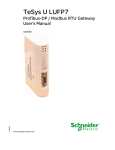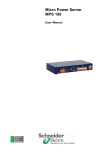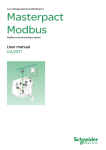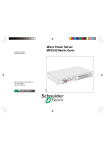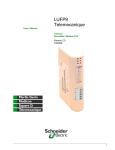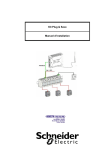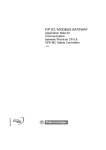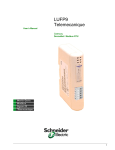Download Schneider Electric LUFP7 User manual
Transcript
LUFP7 A way to make Masterpact available on Profibus Version 1.0 08/2007 Content of the document OBJECTIVE OF THIS DOCUMENT ................................................................................... 3 SAFETY INFORMATION ..................................................................................................... 4 UNDERSTANDING THE PROFIBUS / MODBUS GATEWAY ....................................... 5 OVERVIEW OF THE LUFP7 GATEWAY.......................................................................... 7 INSTALLATION OF THE GATEWAY ............................................................................... 9 PART NUMBERS ........................................................................................................................ 9 MODBUS .................................................................................................................................. 9 Power Supply..................................................................................................................... 10 Modbus wiring:.................................................................................................................. 10 LUFP7 Modbus connector: ............................................................................................... 11 Wire between LUFP7 and junction box: ........................................................................... 11 Junction Box ...................................................................................................................... 12 PROFIBUS ............................................................................................................................... 13 CONFIGURATION OF THE GATEWAY:........................................................................ 15 WIRING .................................................................................................................................. 15 PC COM PORT: ....................................................................................................................... 16 ABC-LUFP CONFIG TOOL ..................................................................................................... 17 DETAILED PROPERTIES OF THE CONFIG TOOL ......................................................................... 18 GENERIC CONFIGURATIONS ......................................................................................... 20 PROPOSED NODES ................................................................................................................... 21 HOW TO USE THESE NODES - EXAMPLE .................................................................................. 22 PROPOSED CONFIGURATION ................................................................................................... 23 Read only configurations................................................................................................... 23 2 Micrologic: current, voltage, energy, power measures + CCM status + Breaker status ........................................................................................................................................... 24 HOW TO USE THESE CONFIGURATIONS ................................................................................... 27 CREATE CONFIGURATION FROM SCRATCH .............................................................................. 28 LIMITATIONS OF THE GATEWAY ................................................................................ 29 ADDENDUM 1: MORE ON MODBUS PROTOCOL:...................................................... 30 ADDENDUM 2: DATA TIME-RELIABILITY CALCULATION................................... 31 2 Objective of this document The aim of this document is to explain how to have Masterpact and Compact NS >630A available on a Profibus network. It does not aim to replace any user manual (neither Masterpact Communication nor LUFP7 user manuals). This document is focused on the LUFP7 - V2 gateway, which is available on the market since beginning 2007. Please consider the limitations before using the LUFP7 gateway with circuit breakers. 3 Safety information Notice Read the device instructions carefully, and look at the equipment to become familiar with the device before trying to install, operate, or maintain it. The following special messages may appear throughout this documentation or on the equipment to warn of potential hazards or call attention to information that clarifies or simplifies a procedure. Disclaimer Please note: Only qualified personnel should service electrical equipment. No responsibility is assumed by Schneider Electric for any consequences arising out of the use of this material or the associated User Manual. This document is not intended as an instruction manual for untrained persons. © 2007 Schneider Electric. All Rights Reserved. 4 Understanding the Profibus / Modbus gateway The LUFP7 gateway allows a master located on a Profibus-DP network to enter into a dialogue with the slaves on a Modbus RTU network. This is a generic protocol converter operating in a way which is transparent to the user. This gateway allows you to interface many products marketed by Schneider Electric with a Profibus-DP network. The LUFP7 gateway behaves both as a Profibus-DP slave on the upstream network and as a Modbus RTU master on the downstream network. The gateway can carry out its data exchanges (inputs and outputs of all types) with the Modbus slaves cyclically, aperiodically or in an event-driven way. All of these Modbus exchanges make up the gateway’s «Modbus scanner» and we use the «ABC-LUFP Config Tool» software application to configure this scanner’s exchanges. Every item of data exchanged in this way is made available for the Profibus-DP master, which can gain access to it in a number of ways (cyclical, aperiodic or event-driven exchange). The Profibus-DP network is totally separate from the Modbus network. The frames on a network are not directly «translated» by the gateway to generate frames on the other network. Instead, the exchanges between the content of the gateway’s memory and the Modbus slaves make up a system which is independent of the one which is entrusted with managing the exchanges between this same memory and the Profibus-DP master. The system guarantees the coherence of data exchanged within the shared memory. 5 The following example illustrates the independent management of each of the two networks: 6 Overview of the LUFP7 gateway Legend: 1 Detachable power connector for the gateway ( 24V ±10%). 2 Female RJ45 connector to a PC running ABC-LUFP Config Tool configuration software. 3 Female RJ45 connector for the downstream Modbus RTU network. 4 Six diagnostic LEDs. 5 Removable cover for the coding wheels used to configure the gateway. The label describing the LEDs is stuck onto this cover. 6 Female Profibus-DP connector. 7 The gateway uses its own memory map, in order to make the link between Modbus and Profibus networks. The inputs data corresponds to the data coming from Modbus that will be available on the profibus network; the Output data are the one coming from the Profibus network and will be used on the Modbus network. The general data are used for the gateway internal purposes. How does the gateway works? The gateway has its own internal configuration that creates the link between both networks and both data space. When configuring the gateway, you create the link by linking the functions (read and write) and the memory. E.g. I want the current on phase 1 to be available on profibus, I have to first create the read command in the LUFP configuration, then the response in which I will indicate where I will write the answer (in the output data), then from profibus I can read the current by sending a read request at the specified address. The important point is that the configuration is fixed, so you have to create offline all the commands and the mapping. Then to send the configuration to the gateway and only then you can get data in the profibus network. 8 Installation of the gateway Part numbers Part number for purchasing LUFP7 VW3A8306D30 CSD309 (50964) CJB306 (50963) VW3A8106 Description: This is the commercial name of the gateway from Profibus to Modbus. This is a 3 meter RJ45 – strip cable. It can be use from the gateway to the Modbus network This is the SubD-9 connector to be used with the junction box This is the junction box to be used to link all the Modbus slave devices RS232 to RS485 convertor + RJ45 wiring, used for configuration (required once only for installation) Modbus Modbus and LUFP7 The LUFP7 accepts the Modbus read holding registers command (0x03), preset single register (0x06) and preset multiple registers (0x10). You can either use the junction box or make a daisy chaining Modbus network. The wiring is similar to any Modbus network wiring, with 2 wires. Masterpact Masterpact Masterpact Masterpact Masterpact Masterpact Masterpact Link to other junction box (if any) 9 Please note that the following information details the solution with junction box. The daisy chain solution can be derived from this. Power Supply The LUFP7 gateway shall be externally power supplied with 24V. This 24V power supply can be common with the BCM Modbus power supply, if the power consumption is compatible (LUFP7 maximum cunsumption is 95mA with 24V). In any case, this power supply shall be isolated from the circuit breaker power supply (if any). Modbus wiring: Overview: Profibus network 24V Modbus network RJ45 – strip wire Junction Bloc + SUBD-9 connector 10 LUFP7 Modbus connector: Wire between LUFP7 and junction box: B (pin4) A (pin5) To LUFP7 B A To junction box Detailed view of the SUBD-9 connector (male part): 9–A 5–B 11 Junction Box The junction box shall be 24V power supply, either directly its 24V connector or from one of the Modbus slave connectors. As the gateway is the Modbus master, it has to be connected to the IN port of the junction bloc. The LUFP7 gateway does only provide a Modbus 2 wire network, thus all the Modbus slaves shall be compliant with a 2 wire Modbus network. For Masterpact, the BCM is compliant with Modbus 2 wire. If you use the junction box CJB306, then you just have to put the switch in the “2 wire” position. Please consider the end of line termination, as in a standard Modbus network. If you decide to use your own wiring solution, then the Modbus BCM has to be wired this way: (Comm+ correspond to B and Comm- correspond to A). 12 Profibus Wiring Connect the SUB-D 9-point male plug on the Profibus-DP connector to the ProfibusDP plug on the LUFP7 gateway. (1) This signal is not mandatory and may be ignored for the LUFP7 gateway. (2) The “GND” and “+5V” pins are meant to supply the line termination if it is present in the connector being used. The wiring is a standard Profibus wiring and shall be done as it. 13 Profibus configuration of the LUFP7 This task is limited to configuring the gateway's Profibus address, as the communication speed on the Profibus network (9.6 kbits/s to 12 Mbits/s) is automatically detected by the gateway. The two coding wheels used for configuring the gateway’s address are hidden behind the gateway cover. To remove this cover, insert the end of a small flat screwdriver between the top of the hood and the gateway box and pull it out. The LUFP7 gateway is identified on the Profibus-DP bus by its address, ranging from 1 to 99. This address is the sum of the decimal values given by the angular positions of the bottom coding wheel (tens) and the top coding wheel (units). The LUFP7 gateway has no active line termination. You must use a Profibus-DP connector with such a termination if you place the gateway at one of the ends of a bus segment. Mapping: The mapping shall be made manually with the ABC config tool with help of its subnetwork monitor function. For this you need to know the content of memory needed by each slave and each functions. Then by removing/adding on commands, you can figure out their address. 14 Configuration of the gateway: ABC-Lufp config tool, which is the configuration software for the LUFP7 gateway can be downloaded from http://www.hms.se/abc_lufp.shtml among with the Lufp7 user guide. Please note that this software shall be installed and used in english in order to allow a suitable import of file (for the example we provide). Wiring The LUFP7 gateway is configured in RS485, so if the configuration is made using a PC, a RS232 to RS485 convertor is required (VW3A8106). 15 In case you are using a different converter, the wiring between PC and LUFP7 configuration port shall be as follow: NOTE: The inversion of the Rx and Tx signals between the gateway and the PC is shown on the 9-point SUB-D connectors, because beyond this junction, the RS-232 signals are replaced by the D(A) and D(B) polarizations of the RS-485 signals. PC Com port: There is no need to configure the PC’s COM port, as ABC-LUFP Config Tool uses a specific setup which replaces the one for the port being used. This replacement is temporary and is cancelled as ABC-LUFP Config Tool stops using this serial port, that is to say when ABC-LUFP Config Tool is closed. 16 ABC-LUFP config tool The main window in the ABC Config Tool can be divided in 4 sections as follows: A: Pull-down Menus & Tool Bar The second drop-down menu from the left will change depending on the current context. The Tool Bar provides quick access to the most frequently used functions. B: Navigation Section This section is the main tool for selecting and altering different levels of the subnetwork configuration. Entries proceeded by a ‘+’ holds further configuration parameters or ‘sub menus’. To gain access to these parameters, the entry must be expanded by clicking ‘+’. There are three main levels in the navigation window, namely Fieldbus, ABC and Sub-network. Right-clicking on entries in this section brings out additional selections related to that particular entry. C: Parameter Section This section holds a list of parameters or options related to the currently selected entry in the Navigation Section. The parameter value may be specified either using a selection box or manually, depending on the parameter itself. Values can be specified in decimal form (e.g. ‘42’), or in hexadecimal format (e.g. ‘0x2A’). D: Information Section This section holds information related to the currently selected parameter. Remark: the configuration can be password protected (File properties or when configuration load), but the password can not be retrieved, so be sure to keep a copy of it in a safe place… 17 Detailed properties of the config tool • Fieldbus settings: the fieldbus type is Profibus-DP, as the gateway is between Modbus and Profibus-DP • ABC-LUFP settings: If you want to have the communication statistics on the Modbus side, you have to enable the statistics and give a location for the counter (in the Input data side of the memory) • Sub-Network settings: you have to fill in the communication parameters of your Modbus network (Speed and Parity). Please note that 8 data bits, RS485 physical standard and 1 stop bits are compulsory when you have Micrologic. The sub-network shall represent the physical reality of your installation (at least what you want to be available on profibus). On right click on the Sub-Network, you can manage your network, either by “sub-network Monitor”, that will display the gateway memory in link with the created nodes and functions or by “sub-network status” that will gives you direct information on your network (available only when gateway is connected). It is also possible for you to add a new Node (Modbus slave), new broadcaster (broadcast functions) and load an existing node. When you add a new node, you have to specify the Modbus slave address in its settings. Then on right click on the node name you have various functions. - Node monitor is used to see the gateway memory used by this node, to start or stop this node and to send any Modbus commands on you network. - Add command is used to add command (query and response), with guided frame (prefilled data) - Add transactions is use to add a transaction, which is the same as a command but without any help (user has to specify all: the size of the request, its request, all the parts of the raw data…). 18 For each command, you need a query and a response (automatically created when you create a new command). The query and response represents most of the Modbus raw data (except the property data as error check start byte) (please check the annex on Modbus if you need refreshment on this topic). e.g. read slaves 1’s register 661: 0x01 0x03 0x0294 0x0001 0x0000 CRC Process for configuration - Open ABC-LUFP config software - Create the configuration (either from scratch or with generic configuration) ) - Connect the PC to the gateway (wiring + software connection - Download configuration to the gateway Check if the configuration is OK (sub-network monitor or node monitor) - Disconnect from the gateway 19 Generic configurations We provide various configurations that can be used as example in order to understand more about how the gateway works and how to configure it. These configurations shall be evolved in order to suit the customer’s needs, while keeping in mind the restrictions. 2 type of file: Configuration file, that represent an existing network Node file, that represent one Modbus slave (Nodes correspond to Modbus slaves) Using ABC-LUFP config tool software you can either open a configuration file, or in an existing configuration you can insert a node from file (insert from file). Whatever your import choice is, you have to be sure the configuration represents the physical network (check the address in the node and its commands…). Moreover you have to be sure that all the nodes either created or imported are compatible within the LUFP7 memory, as each nodes data received or sent are stored in the LUFP memory (this can be checked using the sub-network monitor: red means collision). We have to configure the Modbus side and its link with profibus. If x is the register written in the Micrologic Modbus guide, x-1 has to be written in the configuration tool. If you want to change the name of any node, then press F2. 20 Proposed nodes Name of the node Type of Micrologic Content CCM - Device status N/A: only CCM CCM register 661: - connected position - disconnected position - Test position Input Area address (Hexadecimal) 000 to 001 Output Area address N/A BCM – CB status All Node address: 51 002 to 003 BCM register 661 N/A MM – Currents Node address: 1 MM registers 1016 to 1022 N/A MM - Measures BCM – Control Command All P and H All Node address: 201 MM registers 1016 to 1022(currents), 1000 to 1007(voltages), 1034 to 1045(power) and 2000 to 2027(energy) Node address: 201 Write: 7700 to 7704 004 to 011 004 to 011 (I) N/A 012 to 021 (U, V) 022 to 039 (P, Q, S) 03A to 051 (E) 200 to 209 052 to 054 Trigger 0x210 (command execution status) Read: 802 and 803 Node address: 1 In the proposed node, the refresh time for read is 1s. For the control command, you have to write first the command (E038 0004 0004 0000 (or 0001) and the password), and then change the trigger byte to anything else than the previous value or 00. Input Area corresponds to all the data that will comes from Modbus slaves to the gateway. Output area corresponds to all the data that comes from profibus master to the gateway. 21 While there are various nodes or various commands in one configuration file, they are red from up to down (in the ABC-LUFP config tool software view). This is especially important when you want to write a command, as you have to check the results after having written the commands. The commands can be sent cyclically, on trigger or on data changed. It is recommended to have the read commands sent cyclically and the write command on action (trigger or data change). The refresh / update time can be changed (query / update / Update time), please note that the figure written is in 10ms. In case of modifications, you have to verify that your refresh time is not to high in order to respect the physical limitations of Modbus networks. It is possible to have various nodes at the same address, but it is not advisable, as the software representation will be different from the reality. How to use these nodes - Example These node can be used either directly only in case you have only 1 Micrologic. In case you have more Micrologic, you have to modify: • The slave address (Node / Slave address); it is recommended to check the slave address not only for the node but also for each command in order to ensure a proper address configuration • The data location (for profibus mapping) • For read holding register function: in response / data / data location • For preset multiple register function: in query / data / data location • The trigger byte if any It is strongly advised to create a mapping of the profibus address while making the “translation” from generic node to specific node, as it will be necessary for you to configure your PLC / profibus Master. 22 Proposed configuration All the configurations have been made with parity at even and a baud rate of 19200 bps. Read only configurations 4 Micrologic: current measures + Breaker status Please keep in mind that each 2 Profibus register has to be concatenated in order to correspond to 1 Modbus register. 16 bytes and 2 commands per micrologic Profibus Mapping for Micrologic 1(BCM has slave address 1 and Measurement module 201): Address Detail Circuit breaker status (from Modbus register 661): 0&1 2&3 4&5 6&7 8&9 10 & 11 12 & 13 14 & 15 Bit 0 (0x01) : OF ; Indication contacts For Compact and Masterpact : 0= Breaker is opened, 1 = Breaker is closed Bit 1 (0x02) : SD ; Trip indication contact For Compact : 0 = no trip, 1 = Breaker has tripped due to electrical fault or Shunt trip For Masterpact : always 0 Bit 2 (0x04) : SDE ; Fault trip indication contact For Compact and Masterpact : 0 = no trip, 1 = Breaker has tripped due to electrical fault Bit 3 (0x08) : CH ; Charged (used only with motor mechanism) For Compact : always 0 For Masterpact : 0 = Spring discharged, 1 = Spring loaded Bit 4 (0x10) : Reserved (internal use only) Bit 5 (0x20) : Reserved (internal use only) Bit 6 (0x40) : Compact / Masterpact differentiation 0 = Compact NS , 1 = Masterpact Bit 7-15 : Reserved Nota: A bitmap mask should be used to test the Breaker status. If a value test is used, the following values should be used for Masterpact : 0x44 Tripped discharged not RTC 0x4C Tripped charged not RTC 0x50 OFF discharged not RTC 0x51 ON discharged not RTC 0x59 ON charged RTC 0x78 OFF charged RTC RMS current on phase 1 (1016) RMS current on phase 2 (1017) RMS current on phase 3 (1018) RMS current on Neutral (1019) Max RMS current (1020) Ground fault current (1021) Earth leakage current (1022) For all the other Micrologic, the addresses are just translated by 16 (0x10). 16 to 31 32 to 47 48 to 63 Micrologic 2 (slave address 2 & 202) Micrologic 3 (slave address 3 & 203) Micrologic 4 (slave address 4 & 204) 23 2 Micrologic: current, voltage, energy, power measures + CCM status + Breaker status Profibus Mapping for Micrologic 1(BCM has slave address 1, CCM has address 51 and Measurement module 201): Address Detail Device status: 0&1 2&3 4&5 6&7 8&9 0A & 0B 0C & 0D 0E & 0F 10 & 11 12 & 13 14 & 15 16 & 17 18 & 19 Bit 0 (0x01) : OF ; Indication contacts For Compact and Masterpact : 0= Breaker is opened, 1 = Breaker is closed Bit 1 (0x02) : SD ; Trip indication contact For Compact : 0 = no trip, 1 = Breaker has tripped due to electrical fault or Shunt trip For Masterpact : always 0 Bit 2 (0x04) : SDE ; Fault trip indication contact For Compact and Masterpact : 0 = no trip, 1 = Breaker has tripped due to electrical fault Bit 3 (0x08) : CH ; Charged (used only with motor mechanism) For Compact : always 0 For Masterpact : 0 = Spring discharged, 1 = Spring loaded Bit 4 (0x10) : Reserved (internal use only) Bit 5 (0x20) : Reserved (internal use only) Bit 6 (0x40) : Compact / Masterpact differentiation 0 = Compact NS , 1 = Masterpact Bit 7-15 : Reserved Circuit breaker status (from Modbus register 661): Bit 0 (0x01) : OF ; Indication contacts For Compact and Masterpact : 0= Breaker is opened, 1 = Breaker is closed Bit 1 (0x02) : SD ; Trip indication contact For Compact : 0 = no trip, 1 = Breaker has tripped due to electrical fault or Shunt trip For Masterpact : always 0 Bit 2 (0x04) : SDE ; Fault trip indication contact For Compact and Masterpact : 0 = no trip, 1 = Breaker has tripped due to electrical fault Bit 3 (0x08) : CH ; Charged (used only with motor mechanism) For Compact : always 0 For Masterpact : 0 = Spring discharged, 1 = Spring loaded Bit 4 (0x10) : Reserved (internal use only) Bit 5 (0x20) : Reserved (internal use only) Bit 6 (0x40) : Compact / Masterpact differentiation 0 = Compact NS , 1 = Masterpact Bit 7-15 : Reserved Nota: A bitmap mask should be used to test the Breaker status. If a value test is used, the following values should be used for Masterpact : 0x44 Tripped discharged not RTC 0x4C Tripped charged not RTC 0x50 OFF discharged not RTC 0x51 ON discharged not RTC 0x59 ON charged RTC 0x78 OFF charged RTC RMS current on phase 1 (1016) RMS current on phase 2 (1017) RMS current on phase 3 (1018) RMS current on Neutral (1019) Max RMS current (1020) Ground fault current (1021) Earth leakage current (1022) rms phase-to-phase voltage V12 rms phase-to-phase voltage V23 rms phase-to-phase voltage V31 rms phase-to-neutral voltage V1N 24 1A & 1B 1C & 1D 1E & 1F 20 & 21 22 & 23 24 & 25 26 & 27 28 & 29 2A & 2B 2C & 2D 2E & 2F 30 & 31 32 & 33 34 & 35 36 & 37 38 & 39 3A & 3B 3C & 3D 3E & 3F 40 & 41 42 & 43 44 & 45 46 & 47 48 & 49 4A & 4B 4C & 4D 4E & 4F 50 & 51 52 & 53 54 & 55 00 to 55 60 to B5 rms phase-to-neutral voltage V2N rms phase-to-neutral voltage V3N arithmetic mean of the phase-tophase voltages 1/3 x (V12+V23+V31) arithmetic mean of the phase-toneutral voltages 1/3 x (V1N+V2N+V3N). active power on phase 1 active power on phase 2 active power on phase 3 Total active power reactive power on phase 1 reactive power on phase 2 reactive power on phase 3 total reactive power apparent power on phase 1 with 3 wattmeters apparent power on phase 2 with 3 wattmeters apparent power on phase 3 with 3 wattmeters total apparent power total active energy part1 (mod10000) total active energy part2 total active energy part3 total active energy part4 total reactive energy part1 (mod10000) total reactive energy part2 total reactive energy part3 total reactive energy part4 total apparent energy part1 (mod10000) total apparent energy part2 total apparent energy part3 total apparent energy part4 Status command register Open Status command register Close Micrologic 1 (slave address 1, 51 & 201) Micrologic 2 (slave address 2, 52 & 202) The second Micrologic parameters have to be derived from the table above (translation by 0x55) Profibus mapping for the out area (to be written by Profibus master - control command) Address Detail 0&1 0xE038 (57400) (command number for open or close) 2&3 P1 = 0004 (total number of parameters including P1) 4&5 P2 = 0004 (circuit-breaker manager) 6&7 P3 = 0000 for Open or P3 = 0001 for Close 8&9 P4 = Password (default value = 0000) 0A to 0F free 10 Trigger byte for Micrologic 1 11 to 1F free 20 & 21 0xE038 (57400) (command number for open or close) 25 22 & 23 24 & 25 26 & 27 28 & 29 2A to 2F 30 P1 = 0004 (total number of parameters including P1) P2 = 0004 (circuit-breaker manager) P3 = 0000 for Open or P3 = 0001 for Close P4 = Password (default value = 0000) free Trigger byte for Micrologic 2 To send the command the various step has to be followed: - write the command parameters (from 00 to 09) - change the trigger byte (make it different to 0 and to the previous value) (These both steps can be achieved through 1 Profibus commands) 26 How to use these configurations You can use these configurations as they are, or modify them. When you make a modification, you have to be very careful with the mapping and ensure that there is no overlapping. This can be verified using sub-network monitor, where no red shall be displayed. The ABC-LUFP config tool can also be used to check the Modbus value of the registers and check that the configuration is well done and used. LUFP7 has some Led that have to be checked for debugging and ensuring the configuration works fine (only from protocol standpoints). 27 Create configuration from scratch In order to avoid problems: • • • Create as many node as needed (one node is a Modbus slave) Give the Modbus address to all nodes Create the commands with adequate parameters • 1 Modbus register corresponds to 4 hexadecimal digits. That is 2 Bytes • Query and respond correspond to the Modbus raw data (see annex for more on Modbus raw data) If you create your own node, you have to be sure that the response is correctly configured, even if you don’t need to have this response (this is typically the case when you write a command). In case the response is not the expected one, then the LUFP7 will decide to re-send the command (this could create problems for “on trigger” or “on state of data change” commands). LUFP7 uses register numbers, whereas the Modbus guide for Micrologic gives the register address. Thus 1 shall be deduct from each address (e.g. 7700 command register in Modbus guide correspond to 7699 in the LUFP7 gateway). 28 Limitations of the gateway The gateway will create a bridge between Profibus and Modbus, as this link is hardcoded, it create some memory limitations: - The sum of Input Data and Output Data is limited to 416 bytes max. - Maximum slave number is 8 (this is less for Micrologic, as it is composed of various slave). - Maximum transactions of 100 (this is 50 Modbus commands) - Maximum memory of 512 Bytes (244 bytes of inputs data and 244 bytes of output data) Moreover, as the gateway will act in the Modbus network as a master and as a slave in the Profibus network, it is impossible to have another master in the Modbus network. As Modbus network will be cyclically polled, keep in mind that every Modbus command takes time on the bus before asking for a high refresh time. In case the refresh time is to high, the gateway could not follow it, but will act as fast as possible (minimum stop time between transactions). As the Lufp7 cyclically polls the Micrologic, data in its memory that will be given to the profibus master can be different from the real-time value. This time difference mostly depends on the number of Micrologic and the number of data requested for each (see addendum for delay calculation). If we the time constraints is less real are and if data we want from Micrologic are not specific (available in the communication profile), we could link the gateway with the communication profile located in the BCM, then we can have 8 Micrologic connected to one single LUFP7. Do not forget that communication profile needs to be activated before use. You must check that the size of the Profibus-DP data corresponds to the size of the memory used for the Modbus exchanges, because the gateway configures its Profibus-DP exchanges on the basis of the memory used by the Modbus frames. If the sizes do not match, the fieldbus Diag LED n°4 b links at 1 Hertz frequency, cyclic Modbus exchanges are enabled and write-access Modbus registers are set to 0. 29 Addendum 1: More on Modbus protocol: More on Modbus (function 3 /16): read + Write Modbus function 3 and 16 are supported by the gateway. Function 3: read holding registers Request 2 bits 2 bits Slave address Function code (03) 4 bits 4 bits st Address of the 1 Total number of register requested register required Response 2 bits 2 bits 2 bits Slave address Function code Number of Content of register written (03) byte to follow (1 register = 2 Bytes) Function 16: preset multiple registers Request: 2 bits 2 bits 4 bits 4 bits Slave Function Data Number address code (16 address of of register = 0x10) the 1st to write register to write Response: 2 bits Slave address 2 bits Function code (16) 4 bits CRC 4 bits CRC 2 bits Number Value to write of data bytes to follow (normally nr of reg * 2) 4 bits 4 bits st Address of the 1 Number of register registers writen 4 bits CRC 4 bits CRC 30 Addendum 2: data time-reliability calculation The following figure comes from average figures and shall be used only as time reference, as in some specific cases the delay values can be much higher. The aim is to understand / calculate the maximum time difference between the measures that have been red and the real/physical value. After the LUFP7 has send a Modbus read command to Micrologic (measures or protections): Physical values Micrologic registers Refresh time: 1second BCM registers Maximum read time: 200 ms LUFP7 registers Profibus Master registers Maximum read time: 50 ms In case of a read command to the BCM like breaker status, the delay between the physical switch value and the Modbus availability is 200ms. In case of a read command to the BCM without any query to Micrologic, the delay is 50ms. The LUFP7 will poll continuously on Modbus; this means that as soon as it receives the answer from a slave it will send the next message. In case of 4 Micrologic from which you want to read the measures and the breaker status: The following command will be sent on the bus: - Read current Micrologic 1 (250ms) - Read current Micrologic 2 (250ms) - Read current Micrologic 3 (250ms) - Read current Micrologic 4 (250ms) - Read status Micrologic 1 (50ms) - Read status Micrologic 2 (50ms) - Read status Micrologic 3 (50ms) - Read status Micrologic 4 (50ms) The LUFP7 will then poll the data again after 1.2 seconds. Thus the data in its memory(available on Profibus) will be maximum 2.2 seconds “old”. In case of 8 Micrologic from which we read data from the communication profile: The following commands will be sent on the bus: - Read data from Micrologic 1 (50ms) - Read data from Micrologic 2 (50ms) - Read data from Micrologic 3 (50ms) - Read data from Micrologic 4 (50ms) - Read data from Micrologic 5 (50ms) 31 - Read data from Micrologic 6 (50ms) - Read data from Micrologic 7 (50ms) - Read data from Micrologic 8 (50ms) The data comes directly from the BCM, so the answer time is 50ms. The LUFP7 will be able to poll data every 400ms. Detailed refresh time for the communication profile: Registers written in bold s hall be refreshed every 50 ms (events and alarms) Registers written in bold shall be refreshed every 1.2 s (current & voltage measures) Registers written in italic shall be refreshed every 5 s (other measures: energy…) (Refresh here means loaded from the Micrologic to the BCM, thus the Micrologic internal refresh time shall be added). Let’s take the current measure example: - 1 second Micrologic refresh - 1.2 second BCM refresh - 400 ms LUFP7 refresh So the current measure data available on Profibus will be maximum 2.6 seconds “old”. Worst case: at the gateway limitations: 8 Modbus slave + 50 commands to Micrologic: Each commands will takes 250ms, thus the gateway will poll the same data every 250*50= 12,5 seconds Example of the current measure: - 1 second Micrologic refresh - 50 ms BCM transfer - 12.5 second LUFP7 refresh So the current measure data available on Profibus will be maximum 13,55 seconds “old”. 32
































